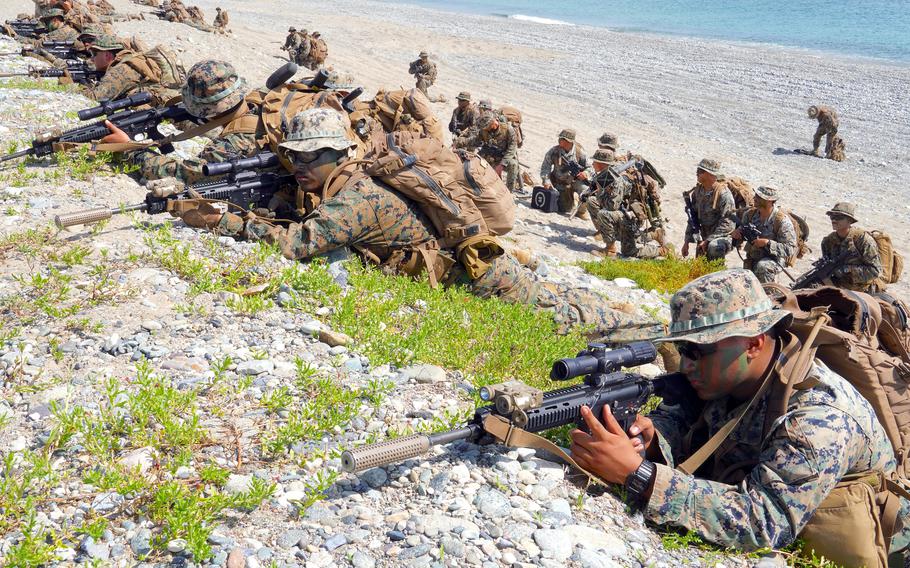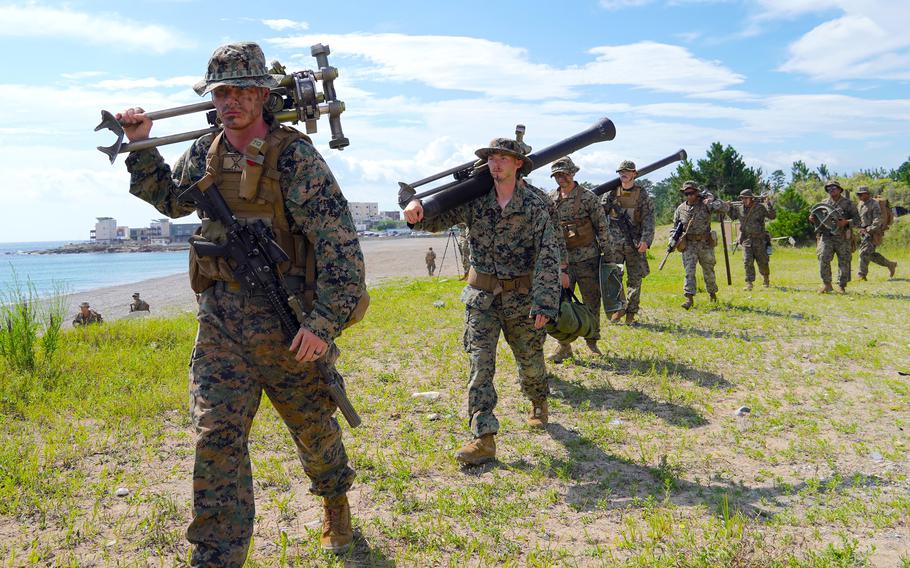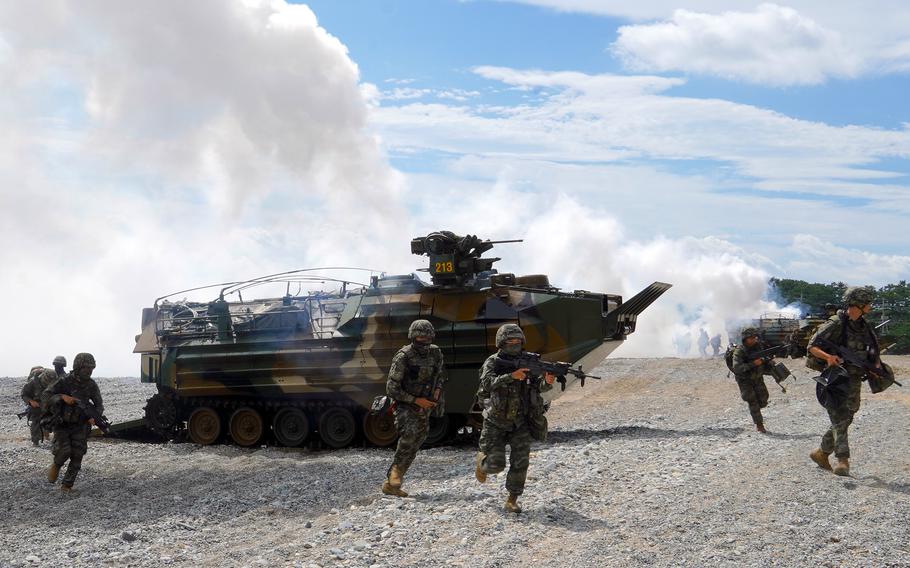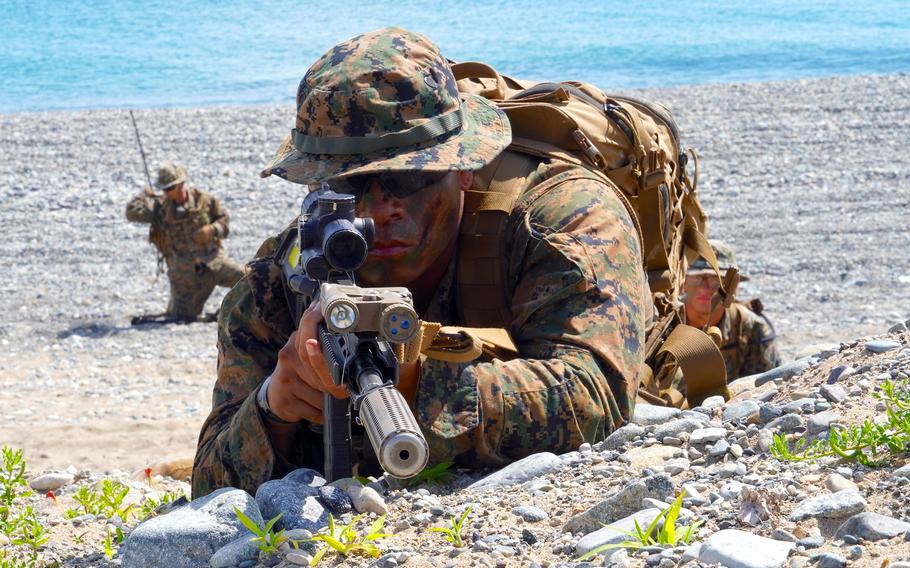
U.S. Marines from 2nd Battalion, 23rd Marine Regiment establish security around a beachhead during the Korean Marine Exercise Program in Pohang, South Korea, on Aug. 6, 2025. (David Choi/Stars and Stripes)
POHANG, South Korea — Reserve Marines from California sampled South Korea’s sweltering summer heat this week during a mock amphibious assault on Pohang Beach, part of their first active-duty call-up in five years.
About 500 members of 2nd Battalion, 23rd Marine Regiment, 4th Marine Division joined 500 South Korean marines for the capstone drill of the month-long Korean Marine Exercise Program, which kicked off July 15.
The Marines of 2/23 were activated on Nov. 1 from their headquarters in Pasadena, Calif., under the Corps’ one-year unit deployment program. They spent six months training at the Air Ground Combat Center in Twentynine Palms before deploying to support the Okinawa-based III Marine Expeditionary Force.

U.S. Marines from 2nd Battalion, 23rd Marine Regiment move to a simulated helicopter landing zone during the Korean Marine Exercise Program in Pohang, South Korea, on Aug. 6, 2025. (David Choi/Stars and Stripes)
On Wednesday at the beachhead, about 150 miles south of Seoul, Marines armed with M4 rifles and 81mm mortars established a security perimeter atop a sand dune, simulating an advance force as they waited for 10 South Korean amphibious assault vehicles to arrive off the southeastern coast.
After the South Koreans disembarked, they joined their U.S. counterparts in securing a simulated helicopter landing zone on a nearby grassy hill, where they awaited pickup from South Korean MUH-1 Marineon and U.S. Army CH-47 Chinook helicopters.
But their rides never came; a thunderstorm alert canceled the flights.
The overcast skies offered little protection from the 91-degree heat and dense humidity. The Marines, some of whom took refuge under nearby bridges and trees, were blessed with a brief afternoon rain shower.

South Korean marines charge out of amphibious assault vehicles during Korean Marine Exercise Program drills in Pohang, South Korea, on Aug. 6, 2025. (David Choi/Stars and Stripes)
“It’s definitely a different heat,” Cpl. Alexandro Omega, a rifleman, told Stars and Stripes at the site.
Despite the weather, Omega said he enjoyed learning about the South Korean marines’ squad-level tactics.
“It’s definitely something that I’ve never experienced before,” he said. “Going out with a unit that’s from a different country is mind-opening because they do things a certain way that we don’t, and we do things a way that they don’t.”
Lt. Col. Davis Gooding, commander of the 2/23, called the exercise a return to fundamentals.
“It’s a very strenuous environment to train in for 20 hours a day, with gear, moving sometimes 10 to 20 miles a day on foot,” he said.

U.S. Marines from 2nd Battalion, 23rd Marine Regiment establish security around a beachhead during the Korean Marine Exercise Program in Pohang, South Korea, on Aug. 6, 2025. (David Choi/Stars and Stripes)
Gooding noted that large-scale amphibious exercises like Wednesday’s are less common in Japan due to limited space.
The Korean Marine Exercise Program is one of several joint drills conducted annually between the U.S. and South Korean militaries. The allies carried out the Freedom Shield exercise March 10-20 and typically hold Ulchi Freedom Shield in August.
U.S. Forces Korea — the command overseeing the 28,500 American troops in the country — characterizes the joint training as defensive and critical to maintaining the alliance with Seoul.
North Korea, which has long condemned the drills as rehearsals for an invasion, has pledged to strengthen its military in response.